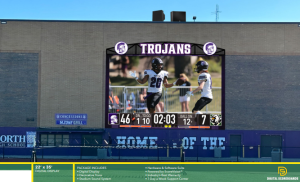Quarantine leads to LGBTQ+ self-discovery

SELF-AWARENESS: Teens discovered more about their own sexual identities during quarantine.
October 14, 2021
Global acceptance of the LGBTQ+ community is on the rise, and queer people are more visible in the media than ever before. It may be too early to tell what the long-term societal effects of COVID-19 will be, but several cultural shifts and one pandemic later, a local phenomenon is apparent: some DGN students are emerging from quarantine with newfound sexualities and gender identities.
“After the first stay-at-home order was lifted, my mom still wouldn’t let me hang out with my friends. I’m not totally resentful of that time, though, because it gave me a chance to reflect and think about myself more,” senior Sydney Fleming said.
Fleming, who identifies as a lesbian, was not out to anyone and barely out to herself when quarantine started. She knew she was attracted to women, but she was unable to decide on a label until isolation gave her the opportunity to thoroughly consider her preferences.
“I could just be myself. I didn’t have to worry about a school full of two thousand people,” Fleming said.
Senior Elena Tomchek echoed Fleming’s sentiments. Solitude compelled Tomchek to wholly submerge herself into her emotions and to think about who she really was when she wasn’t around others.
“Growing up, my best friend’s parents were lesbians, so I was exposed to people with different identities [at a young age],” Tomchek said. “During the summer going into freshman year, I started thinking that maybe I could like girls, but as soon as quarantine began, I took more time to understand what I liked given that I was alone and didn’t need to worry about other people’s opinions.”
Both Fleming and Tomchek used TikTok as a way to interact with other LGBTQ+ teens during quarantine. One in six Generation Z adults identify as something other than heterosexual, and because TikTok’s primary audience is Generation Z, the app became a hub of LGBTQ+ content and user exchanges. When the pandemic made real-life contact between queer people impossible, the internet offered the next best thing.
“TikTok gave me a sense of community even though we’re complete strangers from across the internet. I could see videos of people going through the same thing,” Fleming said. “I saw gay couples together and thought to myself, ‘This is a future I could have.’ Being able to relate to that as a possibility for myself was incredible.”
Rather than questioning their sexuality, which had already been realized prior to the pandemic, sophomore Phoenix Nystrom used quarantine to confront their gender identity.
“It was really tough to figure out. I didn’t have the vocabulary for what gender dysphoria was, and I had no idea where to go off of,” Nystrom said. “I was almost embarrassed to look up stuff [online]. Not being able to experiment with new names or pronouns with my friends was hard to do because everything was remote, and I needed to use my dead name on Zoom.”
Determined to continue their self-discovery despite all the challenges quarantine presented, Nystrom utilized social media to share their journey and connect with others.
“If you scroll through my Instagram, I have, like, five coming out posts. It’s nice that I feel comfortable enough to [talk about this],” Nystrom said.
Sexuality and gender intersected in sophomore Josh Ronquillo’s journey. Ronquillo used quarantine to think about both aspects of his identity, but he acknowledges he still has a long way to go.
“It’s pretty complicated right now, but I am a biromantic homosexual. On the other hand, I am still questioning if I am gender fluid or not,” Ronquillo said. “It took me a little bit to discover my sexuality during quarantine. We weren’t allowed to go out at that time, so I could think about who I really am.”
After returning to school, Ronquillo gained the confidence to cross-dress more frequently. He wore a traditionally “feminine” costume for Halloween during his freshman year and has not looked back since.
“[My outfits] depend on how masculine or feminine I feel on the day. On the days when I wear feminine clothing, there will always be a group of people complimenting me and making me feel so much better about myself, but there is also always the group of people that gives me dirty looks,” Ronquillo said. “It’s not much of a confidence booster, but it makes me laugh on the inside.”
After a period of contemplation during the earlier months of quarantine, LGBTQ+ students started planning to tell others about their identities. Initially desiring to come out to her best friend when quarantine ended, Fleming was unable to do so for several months as COVID-19 refused to subside.
She eventually came out for the first time in November 2020. Fleming feared her identity would prove to be a liability, but when she told her loved ones she was a lesbian, she was quickly accepted with little fanfare.
“I told all my friends and my sister and my mom, and no one cared,” Fleming said. “They were like, ‘Okay, cool!’ My friends automatically switched to making jokes about it with me. I put so much pressure on myself in the beginning, but everything worked out.”
Due to a new full-time in-person school routine, some teenagers are returning to stressful, packed schedules at the expense of rest and reflection time to quell confusion regarding an LGBTQ+ identity. Students are encouraged by DGN mental health specialists to seek help if they are struggling.
“A common sentiment across all students, regardless of race, sexuality, or gender, is the need to be heard and validated. Your sexuality and gender is just one piece of the amazing person you are and all that you can and will become,” school psychologist Angela McAndrews said. “Don’t be afraid to reach out for support. All the counselors, social workers, and psychologists are in room 104 across from the Commons.”
Like McAndrews, Tomchek suggests cultivating a strong personal community.
“Take your time [with your sexuality]. It took me three years to come to terms with my own identity,” Tomchek said. “Trust the people around you and try to find others who will support you for whoever you are.”


























